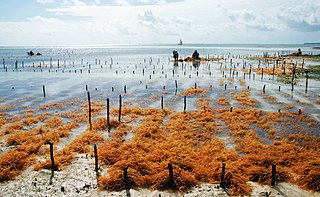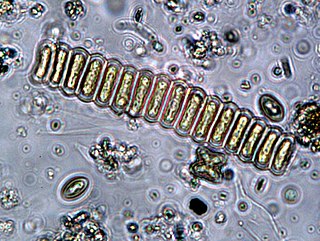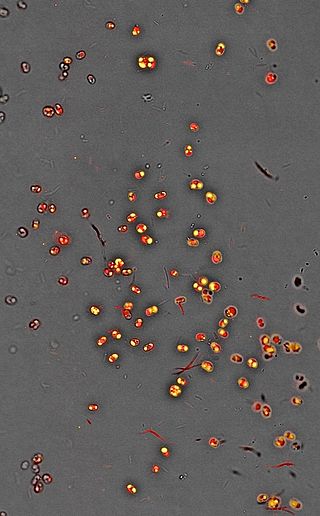Related Research Articles

In chemistry, particularly in biochemistry, a fatty acid is a carboxylic acid with an aliphatic chain, which is either saturated or unsaturated. Most naturally occurring fatty acids have an unbranched chain of an even number of carbon atoms, from 4 to 28. Fatty acids are a major component of the lipids in some species such as microalgae but in some other organisms are not found in their standalone form, but instead exist as three main classes of esters: triglycerides, phospholipids, and cholesteryl esters. In any of these forms, fatty acids are both important dietary sources of fuel for animals and important structural components for cells.

An exoenzyme, or extracellular enzyme, is an enzyme that is secreted by a cell and functions outside that cell. Exoenzymes are produced by both prokaryotic and eukaryotic cells and have been shown to be a crucial component of many biological processes. Most often these enzymes are involved in the breakdown of larger macromolecules. The breakdown of these larger macromolecules is critical for allowing their constituents to pass through the cell membrane and enter into the cell. For humans and other complex organisms, this process is best characterized by the digestive system which breaks down solid food via exoenzymes. The small molecules, generated by the exoenzyme activity, enter into cells and are utilized for various cellular functions. Bacteria and fungi also produce exoenzymes to digest nutrients in their environment, and these organisms can be used to conduct laboratory assays to identify the presence and function of such exoenzymes. Some pathogenic species also use exoenzymes as virulence factors to assist in the spread of these disease-causing microorganisms. In addition to the integral roles in biological systems, different classes of microbial exoenzymes have been used by humans since pre-historic times for such diverse purposes as food production, biofuels, textile production and in the paper industry. Another important role that microbial exoenzymes serve is in the natural ecology and bioremediation of terrestrial and marine environments.
Biodiesel production is the process of producing the biofuel, biodiesel, through the chemical reactions of transesterification and esterification. This process renders a product (chemistry) and by-products.
Fatty acid methyl esters (FAME) are a type of fatty acid ester that are derived by transesterification of fats with methanol. The molecules in biodiesel are primarily FAME, usually obtained from vegetable oils by transesterification. They are used to produce detergents and biodiesel. FAME are typically produced by an alkali-catalyzed reaction between fats and methanol in the presence of base such as sodium hydroxide, sodium methoxide or potassium hydroxide. One reason for using FAME in biodiesel production, rather than free fatty acids, is to mitigate the potential corrosion they can cause to metals of engines, production facilities, and related infrastructure. While free fatty acids are only mildly acidic, over time they can lead to cumulative corrosion. In contrast, their esters, such as FAME, are less corrosive and therefore preferred for biodiesel production. As an improved quality, FAMEs also usually have about 12-15 units higher cetane number than their unesterified counterparts.
In chemistry, acid value is a number used to quantify the acidity of a given chemical substance. It is the quantity of base, expressed as milligrams of KOH required to neutralize the acidic constituents in 1 gram of a sample. The acid value measures the acidity of water-insoluble substances like oils, fats, waxes and resins, which do not have a pH value.
The word metagenics uses the prefix meta and the suffix gen. Literally, it means "the creation of something which creates". In the context of biotechnology, metagenics is the practice of engineering organisms to create a specific enzyme, protein, or other biochemicals from simpler starting materials. The genetic engineering of E. coli with the specific task of producing human insulin from starting amino acids is an example. E. coli has also been engineered to digest plant biomass and use it to produce hydrocarbons in order to synthesize biofuels. The applications of metagenics on E. coli also include higher alcohols, fatty-acid based chemicals and terpenes.

Algaculture is a form of aquaculture involving the farming of species of algae.

Scenedesmus is a genus of green algae, in the class Chlorophyceae. They are colonial and non-motile. They are one of the most common components of phytoplankton in freshwater habitats worldwide.

Choricystis is a genus of green algae in the class Trebouxiophyceae, considered a characteristic picophytoplankton in freshwater ecosystems. Choricystis, especially the type species Choricystis minor, has been proposed as an effective source of fatty acids for biofuels. Choricystis algacultures have been shown to survive on wastewater. In particular, Choricystis has been proposed as a biological water treatment system for industrial waste produced by the processing of dairy goods.

Algae fuel, algal biofuel, or algal oil is an alternative to liquid fossil fuels that uses algae as its source of energy-rich oils. Also, algae fuels are an alternative to commonly known biofuel sources, such as corn and sugarcane. When made from seaweed (macroalgae) it can be known as seaweed fuel or seaweed oil.
Winterizationof oil is a process that uses a solvent and cold temperatures to separate lipids and other desired oil compounds from waxes. Winterization is a type of fractionation, the general process of separating the triglycerides found in fats and oils, using the difference in their melting points, solubility, and volatility.
LS-9 Inc was a venture-funded company focused on producing diesel fuel from transgenic organisms. It launched in 2005, took in $81 million in investment, and in 2013 was sold to Renewable Energy Group for $40 million in cash and stock, and an additional $21.5 million if technology and production milestones were met.

Phospholipid-derived fatty acids (PLFAs) are widely used in microbial ecology as chemotaxonomic markers of bacteria and other organisms. Phospholipids are the primary lipids composing cellular membranes. Phospholipids can be saponified, which releases the fatty acids contained in their diglyceride tail. Once the phospholipids of an unknown sample are saponified, the composition of the resulting PLFA can be compared to the PLFA of known organisms to determine the identity of the sample organism. PLFA analysis may be combined with other techniques, such as stable isotope probing to determine which microbes are metabolically active in a sample. PLFA analysis was pioneered by D.C. White at the University of Tennessee, in the early to mid 1980s.

In biochemistry, lipase refers to a class of enzymes that catalyzes the hydrolysis of fats. Some lipases display broad substrate scope including esters of cholesterol, phospholipids, and of lipid-soluble vitamins and sphingomyelinases; however, these are usually treated separately from "conventional" lipases. Unlike esterases, which function in water, lipases "are activated only when adsorbed to an oil–water interface". Lipases perform essential roles in digestion, transport and processing of dietary lipids in most, if not all, organisms.

Nannochloropsis is a genus of algae comprising six known species. The genus in the current taxonomic classification was first termed by Hibberd (1981). The species have mostly been known from the marine environment but also occur in fresh and brackish water. All of the species are small, nonmotile spheres which do not express any distinct morphological features that can be distinguished by either light or electron microscopy. The characterisation is mostly done by rbcL gene and 18S rRNA sequence analysis.

Nannochloropsis is a genus of alga within the heterokont line of eukaryotes, that is being investigated for biofuel production. One marine Nannochloropsis species has been shown to be suitable for algal biofuel production due to its ease of growth and high oil content, mainly unsaturated fatty acids and a significant percentage of palmitic acid. It also contains enough unsaturated fatty acid linolenic acid and polyunsaturated acid for a quality biodiesel.

Rhizopus oryzae is a filamentous heterothallic microfungus that occurs as a saprotroph in soil, dung, and rotting vegetation. This species is very similar to Rhizopus stolonifer, but it can be distinguished by its smaller sporangia and air-dispersed sporangiospores. It differs from R. oligosporus and R. microsporus by its larger columellae and sporangiospores. The many strains of R. oryzae produce a wide range of enzymes such as carbohydrate digesting enzymes and polymers along with a number of organic acids, ethanol and esters giving it useful properties within the food industries, bio-diesel production, and pharmaceutical industries. It is also an opportunistic pathogen of humans causing mucormycosis.

Thraustochytrids are single-celled saprotrophic eukaryotes (decomposers) that are widely distributed in marine ecosystems, and which secrete enzymes including, but not limited to amylases, proteases, phosphatases. They are most abundant in regions with high amounts of detritus and decaying plant material. They play an important ecological role in mangroves, where they aid in nutrient cycling by decomposing decaying matter. Additionally, they contribute significantly to the synthesis of omega-3 polyunsaturated fatty acids (PUFAs): docosahexaenoic acid (DHA), and eicosapentaenoic acid (EPA), which are essential fatty acids for the growth and reproduction of crustaceans. Thraustochytrids are members of the class Labyrinthulea, a group of protists that had previously been incorrectly categorized as fungi due to their similar appearance and lifestyle. With the advent of DNA sequencing technology, labyrinthulomycetes were appropriately placed with other stramenopiles and subsequently categorized as a group of Labyrinthulomycetes.
An oleaginous microorganism is a type of microbe that accumulates lipid as a normal part of its metabolism. Oleaginous microbes may accumulate an array of different lipid compounds, including polyhydroxyalkanoates, triacylglycerols, and wax esters. Various microorganisms, including bacteria, fungi, and yeast, are known to accumulate lipids. These organisms are often researched for their potential use in producing fuels from waste products.
Torulaspora globosa is a yeast fungus in the genus Torulaspora. This species can be found in the rhizosphere and is beneficial for agricultural activities. Considered a plant growth promoting rhizobacteria, this species helps with plant health maintenance. It is important for biofuel production and is a promising biocontrol agent.
References
- ↑ Boonyarit, Jeerapan; Polburee, Pirapan; Khaenda, Bongkot; Zhao, Zongbao; Limtong, Savitree (23 March 2020). "Lipid Production from Sugarcane Top Hydrolysate and Crude Glycerol with Rhodosporidiobolus fluvialis Using a Two-Stage Batch-Cultivation Strategy with Separate Optimization of Each Stage". Microorganisms. 8 (3): 453. doi: 10.3390/microorganisms8030453 . PMC 7143989 . PMID 32210119.
The most recent generation of biodiesel is derived from microbial lipids. [...] Oleaginous yeasts are a yeast species that can accumulate more than 20% of their biomass in lipids during lipid production. Strains of this species include Cryptococcus albidus, Lipomyces starkeyi, Rhodosporidium toruloides, Rhodotorula glutinis, and Yarrowia lipolytica [...] and are all considered suitable microorganisms for lipid production because of their ability to use a wide range of low-cost substrates.
- ↑ Leman, Jacek (1997). "Oleaginous Microorganisms: An Assessment of the Potential". Advances in Applied Microbiology Volume 43. Vol. 43. pp. 195–243. doi:10.1016/S0065-2164(08)70226-0. ISBN 978-0-12-002643-2. PMID 9097415.
- ↑ Zhu, L.Y.; Zong, M.H.; Wu, H. (November 2008). "Efficient lipid production with Trichosporonfermentans and its use for biodiesel preparation". Bioresource Technology. 99 (16): 7881–7885. Bibcode:2008BiTec..99.7881Z. doi:10.1016/j.biortech.2008.02.033. PMID 18394882.
- 1 2 Zeng, Jijiao; Zheng, Yubin; Yu, Xiaochen; Yu, Liang; Gao, Difeng; Chen, Shulin (1 January 2013). "Lignocellulosic biomass as a carbohydrate source for lipid production by Mortierella isabellina". Bioresource Technology. 128: 385–391. Bibcode:2013BiTec.128..385Z. doi:10.1016/j.biortech.2012.10.079. PMID 23201519.
- ↑ Gao, Difeng; Zeng, Jijiao; Zheng, Yubin; Yu, Xiaochen; Chen, Shulin (April 2013). "Microbial lipid production from xylose by Mortierella isabellina". Bioresource Technology. 133: 315–321. Bibcode:2013BiTec.133..315G. doi:10.1016/j.biortech.2013.01.132. PMID 23434808.
- ↑ Fakas, S.; Papanikolaou, S.; Galiotou-Panayotou, M.; Komaitis, M.; Aggelis, G. (October 2008). "Organic nitrogen of tomato waste hydrolysate enhances glucose uptake and lipid accumulation in Cunninghamella echinulata". Journal of Applied Microbiology. 105 (4): 1062–1070. doi:10.1111/j.1365-2672.2008.03839.x. PMID 18489559. S2CID 23690122.
- ↑ Stressler, Timo; Eisele, Thomas; Rost, Johanna; Haunschild, Eva-Maria; Kuhn, Andreas; Fischer, Lutz (March 2013). "Production of Polyunsaturated Fatty Acids by Mortierella alpina Using Submerse and Solid State Fermentation". Chemie Ingenieur Technik. 85 (3): 318–322. doi:10.1002/cite.201200094.
- ↑ Middelberg, Anton P.J. (January 1995). "Process-scale disruption of microorganisms". Biotechnology Advances. 13 (3): 491–551. doi:10.1016/0734-9750(95)02007-P. PMID 14536098.
- ↑ Soxhlet, F. (1879). "Die gewichtsanalytische Bestimmung des Milchfettes" [The weight-analytical determination of milk fat]. Polytechnisches Journal (in German). 232: 461–465. Archived from the original on 2018-10-08. Retrieved 2021-09-14.
- ↑ Folch, Jordi; Lees, M.; Stanley, G.H. Sloane (May 1957). "A Simple Method for the Isolation and Purification of Total Lipides From Animal Tissues". Journal of Biological Chemistry. 226 (1): 497–509. doi: 10.1016/S0021-9258(18)64849-5 . PMID 13428781.
- ↑ Rupilius, Wolfgang; Ahmad, Salmiah (June 2006). "The Changing World of Oleochemicals". Palm Oil Developments: 15–28.
- ↑ Noweck, Klaus; Grafahrend, Wolfgang (2006). "Fatty Alcohols". Ullmann's Encyclopedia of Industrial Chemistry. doi:10.1002/14356007.a10_277.pub2. ISBN 978-3-527-30673-2.